
Grevillea hilliana, of the plant family Proteaceae, is a species of Australian endemic trees known by many common names including white yiel yiel, white silky oak, grey oak, Hill's silky oak, and yill gill.

Eidothea hardeniana, commonly named nightcap oak, is a species of tree, up to 40 m (130 ft) tall, of the plant family Proteaceae, which botanist Robert Kooyman recognised as a new species only recently in 2002. The species has an official listing as critically endangered on the Australian Commonwealth EPBC Act and as Endangered on the NSW Threatened Species Act. The name hardeniana honours the botanist Gwen Harden. Phylogenetics studies now suggest it represents a basal branch of the Proteoid clade of the Proteaceae.
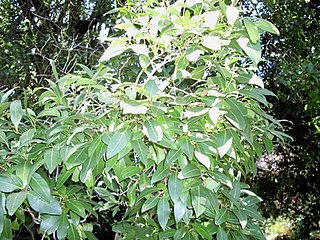
Beilschmiedia elliptica, known as the grey walnut is a rainforest laurel growing in eastern Australia. The range of natural distribution is from Forster, New South Wales to Fraser Island in south eastern Queensland. Beilschmiedia elliptica grows in warm temperate and sub tropical rainforests. Not a rare species, but seldom identified in the rainforest.

Daphnandra johnsonii, also known as the Illawarra socketwood, is a rare rainforest tree in the Illawarra district of eastern Australia.
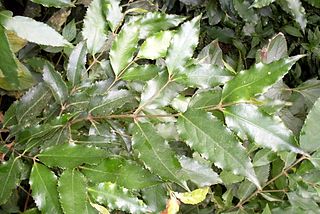
Daphnandra is a genus of shrubs and trees in the family Atherospermataceae, or formerly Monimiaceae. The genus is endemic to Australia.

Numinbah Nature Reserve is a protected nature reserve that is located in the Northern Rivers region of New South Wales, in eastern Australia. The reserve was gazetted in December 1981 with a further addition made in 1989 to make the reserve to its current area of 858 hectares. The reserve is situated north-east of the rural locality of Numinbah, and south of the Queensland town of Springbrook and defines part of the state border between New South Wales and Queensland.

Daphnandra apatela, the socketwood, light yellowwood or canary socketwood is a common rainforest tree in eastern Australia. It grows in the more fertile alluvial soils and basaltic soils. Distributed from the Watagan Mountains in New South Wales to Miriam Vale near Gladstone in Queensland.
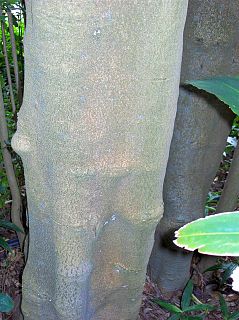
Daphnandra micrantha, the socketwood or Manning River socketwood is a rainforest tree in eastern Australia. It grows near streams in various types of rainforest. Restricted to the Manning River and Hastings River valleys of northern eastern New South Wales. Also seen in ecotone areas dominated by brush box and tallowwood.
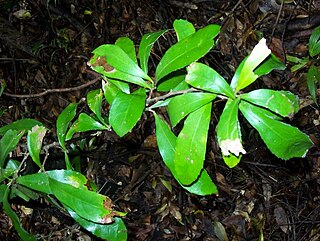
Helicia glabriflora is a species of rainforest shrubs or small trees occurring in eastern Australia. Common names include smooth or pale helicia, pale, leather or brown oak. They grow naturally in a variety of different rainforest types from the Illawarra, New South Wales to the Townsville area, Queensland. Of all the global diversity of approximately one hundred Helicia species, this one species naturally grows the furthest south, in the Minnamurra Rainforest and the Robertson area, Illawarra, New South Wales, there observed more on the relatively fertile basalt and alluvial soils.

Ochrosia moorei, known as the southern ochrosia is a rainforest plant of eastern Australia. Endangered by extinction, it has a ROTAP rating of 2ECi.

Alectryon tomentosus, commonly known as the hairy birds eye, red jacket or woolly rambutan, is a rainforest tree of the family Sapindaceae found in eastern Australia. The specific epithet tomentosus refers to the hairy leaves and hairy young shoots.
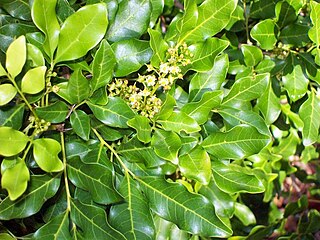
Toechima tenax, known as the brush teak, is a rainforest tree found in eastern Australia. The specific epithet tenax probably refers to the tough wood.

Archidendron hendersonii, the White Lace Flower or Tulip Siris is a rainforest tree in eastern Australia. A rare plant, listed as vulnerable. The plant is named after J.A. Henderson, who collected the original specimen at Ballina. It grows north from the Richmond River, New South Wales up to Cape Melville in tropical Queensland.

Rhodamnia whiteana, known as the cliff malletwood or White's malletwood is a sub-tropical rainforest plant of eastern Australia.

Elattostachys xylocarpa, known as the white tamarind or short-leaf beetroot is a common rainforest tree of eastern Australia. Found in the drier rainforests, which are based on volcanic soils. From as far south as the Orara River in northern New South Wales to Bowen in tropical Queensland. The name Elattostachys refers to "little spikes", a flower feature of other plants in this genus. xylocarpa refers to the hard woody fruit.

Gossia fragrantissima, the sweet myrtle or small-leaved myrtle, is a shrub or small tree of eastern Australia. A plant with a ROTAP rating of 3EC-, endangered by extinction. Found in sub tropical rainforests near streams, from near Woodburn, New South Wales to Nambour in south eastern Queensland. It features fragrant flowers, hence the specific epithet fragrantissima. White flowers grow from October to February.
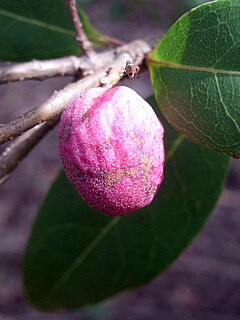
Notelaea ligustrina, known as the privet mock olive, native olive, doral or silkwood, is a plant in the olive family, found in south eastern Australia. Growing in and near rainforests south of Monga National Park in New South Wales, and into Victoria and the island state of Tasmania. The specific epithet ligustrina refers to the Privet, which it resembles.
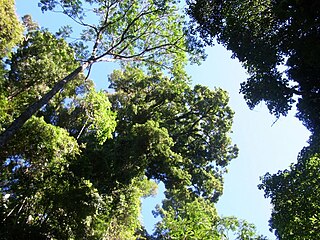
Daphnandra tenuipes, commonly known as the socket sassafrass, or red-flowered socketwood is a rainforest tree in eastern Australia. It grows on the more fertile basaltic and alluvial soils. Found from near Boorganna Nature Reserve near Taree, New South Wales to just over the border into Queensland at Springbrook National Park. It is a small to medium-sized tree featuring red new shoots and red flowers. It has dark green leaves which are lanceolate or ovate, and measure 4–13 cm (1.5–5 in) in length and 1.5–3 cm (0.59–1.18 in) wide.

Atherosperma moschatum subsp. integrifolium is a small evergreen tree native to the temperate rainforests of central and northern New South Wales, Australia. In 2006, it was recognised as a separate subspecies by Richard Schodde. Common names include "southern sassafras - narrow leaf form" and "blackheart sassafras".

Pilidiostigma glabrum, the plum myrtle, is a small tree or shrub native to the rainforests of eastern Australia. Commonly seen in disturbed sites from near Port Macquarie in the south to Fraser Island in the north.



















